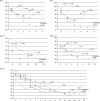The association of dropout and outcome in trials of antipsychotic medication and its implications for dealing with missing data
- PMID: 18212325
- PMCID: PMC2632395
- DOI: 10.1093/schbul/sbm161
The association of dropout and outcome in trials of antipsychotic medication and its implications for dealing with missing data
Abstract
Objective: The extent to which noncompletion of a clinical trial relates to outcomes has implications for choosing the most appropriate method for contending with missing data due to dropout. We examined whether dropout relates to outcome in clinical trials of antipsychotic medication.
Methods: Data from 5 large clinical trials of schizophrenia (n=3483) were examined separately. Patients were aggregated into groups based on their final study visit. Group mean Positive and Negative Syndrome Scale (PANSS) total scores for each visit were computed and graphed. Change from baseline to end point for each group was computed and examined using ANCOVA. Cox regression modeling was used to examine baseline PANSS total and change as predictors of time to dropout.
Results: In all 5 trials there was a statistically significantly relationship between time in trial and improvement. The longer the patients remained in the trial the more that they improved, with trial completers showing the most improvement at each time point. Higher baseline PANSS scores and symptom deterioration indicated by increased PANSS preceding the final study visit prior to dropout corresponded significantly with a greater likelihood of dropout.
Conclusions: Dropout in clinical trials of antipsychotic medications corresponds with efficacy outcomes, the dynamics of symptom change and baseline symptom severity. Therefore, methods for statistical analysis should examine both efficacy and dropout and cannot assume that missing data due to dropout are completely at random.
Figures
Similar articles
-
Modelling and simulation of the Positive and Negative Syndrome Scale (PANSS) time course and dropout hazard in placebo arms of schizophrenia clinical trials.Clin Pharmacokinet. 2012 Apr 1;51(4):261-75. doi: 10.2165/11598460-000000000-00000. Clin Pharmacokinet. 2012. PMID: 22420580
-
A latent variable approach in simultaneous modeling of longitudinal and dropout data in schizophrenia trials.Eur Neuropsychopharmacol. 2013 Nov;23(11):1570-6. doi: 10.1016/j.euroneuro.2013.03.004. Epub 2013 Apr 18. Eur Neuropsychopharmacol. 2013. PMID: 23602612 Clinical Trial.
-
Pharmacokinetic-pharmacodynamic modeling of antipsychotic drugs in patients with schizophrenia Part I: the use of PANSS total score and clinical utility.Schizophr Res. 2013 May;146(1-3):144-52. doi: 10.1016/j.schres.2013.02.011. Epub 2013 Mar 6. Schizophr Res. 2013. PMID: 23473810
-
The impact of trial characteristics on premature discontinuation of antipsychotics in schizophrenia.Eur Neuropsychopharmacol. 2013 Sep;23(9):1010-6. doi: 10.1016/j.euroneuro.2013.03.006. Epub 2013 Apr 30. Eur Neuropsychopharmacol. 2013. PMID: 23639793 Review.
-
Exploratory analyses of efficacy data from schizophrenia trials in support of new drug applications submitted to the US Food and Drug Administration.J Clin Psychiatry. 2012 Jun;73(6):856-64. doi: 10.4088/JCP.11r07539. Epub 2012 May 15. J Clin Psychiatry. 2012. PMID: 22687813 Review.
Cited by
-
Human disease biomarker panels through systems biology.Biophys Rev. 2021 Oct 13;13(6):1179-1190. doi: 10.1007/s12551-021-00849-y. eCollection 2021 Dec. Biophys Rev. 2021. PMID: 35059036 Free PMC article. Review.
-
The effects of a group-based intervention through physical activities and dietary changes in young patients with severe psychiatric disorders: a pilot study.Front Sports Act Living. 2023 Aug 22;5:1197925. doi: 10.3389/fspor.2023.1197925. eCollection 2023. Front Sports Act Living. 2023. PMID: 37674637 Free PMC article.
-
Population Pharmacokinetics of Risperidone and Paliperidone in Schizophrenia: A Systematic Review.Pharmaceuticals (Basel). 2025 May 8;18(5):698. doi: 10.3390/ph18050698. Pharmaceuticals (Basel). 2025. PMID: 40430517 Free PMC article. Review.
-
A Comprehensive Bibliometric Analysis of Biomedical Research Waste: Current Situation, Development, and Trends.Med Sci Monit. 2025 Jun 27;31:e948390. doi: 10.12659/MSM.948390. Med Sci Monit. 2025. PMID: 40574270 Free PMC article.
-
Initial severity of the Positive and Negative Syndrome Scale (PANSS)-30, its main subscales plus the PANSS-6, and the relationship to subsequent improvement and trial dropout: a pooled participant-level analysis of 18 placebo-controlled risperidone and paliperidone trials.Transl Psychiatry. 2023 Jun 7;13(1):191. doi: 10.1038/s41398-023-02491-6. Transl Psychiatry. 2023. PMID: 37286548 Free PMC article. Clinical Trial.
References
-
- Wahlbeck K, Tuunainen A, Ahokas A, Leucht S. Dropout rates in randomised antipsychotic drug trials. Psychopharmacology (Berl) 2001;155:230–233. - PubMed
-
- Martin JL, Perez V, Sacristan M, Rodriguez-Artalejo F, Martinez C, Alvarez E. Meta-analysis of drop-out rates in randomised clinical trials, comparing typical and atypical antipsychotics in the treatment of schizophrenia. Eur Psychiatry. 2006;21:11–20. - PubMed
-
- Lavori PW. Clinical trials in psychiatry: should protocol deviation censor patient data? Neuropsychopharmacology. 1992;6:39–48. discussion 49–63. - PubMed
-
- Ali MW, Siddiqui O. Multiple imputation compared with some informative dropout procedures in the estimation and comparison of rates of change in longitudinal clinical trials with dropouts. J Biopharm Stat. 2000;10:165–181. - PubMed
MeSH terms
Substances
LinkOut - more resources
Full Text Sources
Medical


